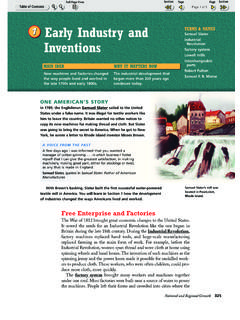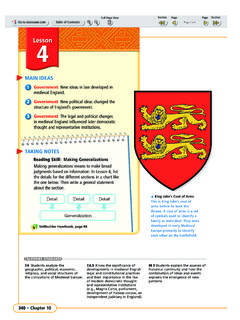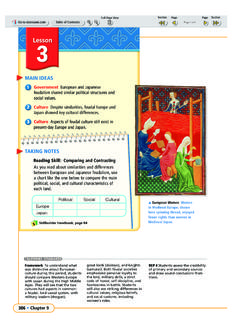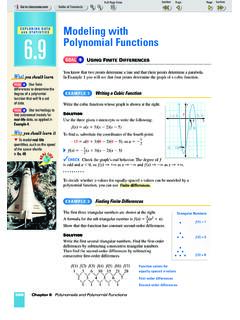Transcription of 4 The California Gold Rush - Mr Thompson
1 396-401US8P R U4C13S4 11/26/02 2:56 PM Page 396. Page 1 of 6. 4 The California TERMS & NAMES. forty-niner Californio gold rush Mariano Vallejo John Sutter James Marshall California gold rush MAIN IDEA WHY IT MATTERS NOW. gold was found in California , and The gold rush made California grow thousands rushed to that territory. rapidly and helped bring about California quickly became a state. California 's cultural diversity. ONE AMERICAN'S STORY. Luzena Wilson said of the year 1849, The gold excitement spread like wildfire. The year before, James Marshall had discovered gold in California . Luzena's husband decided to become a forty-niner . someone who went to California to find gold , starting in 1849. Most forty-niners left their families behind, but Luzena traveled to California with her husband. She later said, I thought where he could go I could, and where I went I could take my two little toddling babies.
2 Luzena discovered that women and their homemaking skills were rare in California . Shortly after she arrived, a miner offered her five dollars for the biscuits she was baking. Shocked, she just stared at him. He quickly doubled his offer and paid in gold . Luzena realized she could make money by feeding miners, so she opened a hotel. This woman is carrying food to Like the Wilsons, thousands of people from around the world miners, just as Luzena Wilson did. became forty-niners. In this section, you will read about the forty-niners and what their mining experiences were like. You will learn how the rapid growth of California 's population caused problems for the people who lived there before 1849. You will also discover how the gold rush boosted California 's economy and changed the nation's history. California Before the rush Before the forty-niners came, California was populated by as many as 150,000 Native Americans and 6,000 Californios settlers of Spanish or Mexican descent.
3 Most Californios lived on huge cattle ranches. They had acquired their estates when the Mexican government took away the land that once belonged to the California missions. One important Californio was Mariano Vallejo (mah RYAH noh vah YEH hoh). A member of one of the oldest Spanish families in America, he owned 250,000 acres of land. Proudly describing the accomplishments of the Californios, Vallejo wrote, We were the pioneers of the Pacific coast .. while General Washington was carrying on the war of the Revolution. Vallejo himself had been the commander of Northern California when it belonged to Mexico. 396 CHAPTER 13. 396-401US8P R U4C13S4 11/26/02 2:56 PM Page 397. Page 2 of 6. Vocabulary When Mexico owned California , its government feared American immigration: immigration and rarely gave land to foreigners. But John Sutter, a Swiss the movement immigrant, was one exception. Dressed in a secondhand French army of people into a country or region uniform, Sutter had visited the Mexican governor in 1839.
4 A charming where they were man, Sutter persuaded the governor to grant him 50,000 acres in the not born unsettled Sacramento Valley. Sutter built a fort on his land and dreamed of creating his own personal empire based on agriculture. In 1848, Sutter sent a carpenter named James Marshall to build a sawmill on the nearby American River. One day Marshall inspected the canal that brought water to Sutter's Mill. He later said, My eye was caught by a glimpse of something shining.. I reached my hand down and picked it up; it made my heart thump for I felt certain it was gold .. rush for gold News of Marshall's thrilling discovery spread rapidly. From all over California , people raced to the American River starting the California gold rush . A gold rush occurs when large numbers of people move to a site Clipper ship companies used advertising cards such as this where gold has been found. Throughout history, people one to convince Easterners that have valued gold because it is scarce, beautiful, easy to their line provided the fastest, shape, and resistant to tarnish.
5 Most pleasant voyages. Miners soon found gold in other streams flowing out of How has the artist tried to project a positive the Sierra Nevada Mountains. Colonel R. B. Mason, image for sailing west? the military governor of California , estimated that the region held enough gold to pay the cost of the present war with Mexico a hundred times over. He sent this news to Washington with a box of gold dust as proof. The following year thousands of gold seekers set out to make their fortunes. A forty-niner who wished to reach California from the East had a choice of three routes, all of them dangerous: 1. Sail 18,000 miles around South America and up the Pacific coast suffering from storms, seasickness, and spoiled food. 2. Sail to the narrow Isthmus of Panama, cross overland (and risk catching a A. Categorizing What were the deadly tropical disease), and then sail to three different California .
6 Types of trans- 3. Travel the trails across North America . portation that people took to braving rivers, prairies, mountains, and get to California ? all the hardships of the trail. A. Answer People used ships, horses, Because the adventure was so difficult, riverboats, cov- most gold seekers were young men. A gray ered wagons, and beard is almost as rare as a petticoat, observed one they also walked. miner. Luzena Wilson said that during the six months she lived in the mining city of Sacramento, she saw only two other women. Manifest Destiny 397. 396-401US8P R U4C13S4 11/26/02 2:56 PM Page 398. Page 3 of 6. Life in the Mining Camps The mining camps had colorful names like Mad Mule LEVI'S BLUE JEANS. Gulch, Hangtown, and Coyote Diggings. They began Nearly everyone in the United as rows of tents along the streams flowing out of the States owns at least one pair of Sierra Nevada. Gradually, the tents gave way to rough faded, comfortable blue jeans.
7 Wooden buildings that housed stores and saloons. The first jeans were invented for California miners. Mining camps could be dangerous. One woman who In 1873, a man named Levi lived in the region wrote about camp violence. Strauss wanted to sell sturdy pants to miners. Strauss made A VOICE FROM THE PAST. his pants out of the strongest fabric he could buy cotton In the short space of twenty-four days, we have had denim. He reinforced the murders, fearful accidents, bloody deaths, a mob, pockets with copper rivets so whippings, a hanging, .. and a fatal duel. that they could hold heavy tools Louise Clappe, quoted in Frontier Women without ripping. For more than 125 years, jeans have remained popular. The mining life was hard for other reasons. Camp Levi Strauss's pants have gossip told of miners who grew rich overnight by find- proved to be ing eight-pound nuggets, but in reality, such easy pick- durable in more ways ings were rare.
8 Miners spent their days standing than one. knee-deep in icy streams, where they sifted through tons of mud and sand to find small amounts of gold . Exhaustion, poor food, and disease all damaged the miners' health. Not only was acquiring gold brutally difficult, but the B. Making miners had to pay outrageously high prices for basic supplies. Inferences Why In addition, gamblers and con artists swarmed into the do you think life in the mining camps to swindle the miners of their money. As a result, few camps was so miners grew rich. rough? B. Possible Miners from Around the World Responses Mining was dirty About two-thirds of the forty-niners were Americans. Most of and dangerous. It these were white men many from New England. However, attracted dishon- est people. Native Americans, free blacks, and enslaved African Americans also worked the mines. Thousands of experienced miners came from Sonora in Mexico.
9 Other foreign miners came from Europe, South America, Australia, and C. Possible China. Most of the Chinese miners were peasant farmers who fled from Response Americans were a region that had suffered several crop failures. By the end of 1851, one unhappy about of every ten immigrants was Chinese. Chinese success Used to backbreaking labor in their homeland, the Chinese proved to and suspicious of their different be patient miners. They would take over sites that American miners had customs. abandoned because the easy gold was gone. Through steady, hard work, the Chinese made these played-out sites yield profits. American min- C. Analyzing Causes Why did ers resented the success of the Chinese and were suspicious of their some Americans different foods, dress, and customs. As the numbers of Chinese miners resent Chinese grew, American anger toward them also increased. miners? 398 CHAPTER 13.
10 396-401US8P R U4C13S4 11/26/02 2:57 PM Page 399. Page 4 of 6. Surface Mining gold is found in cracks, called veins, in the earth's rocky crust. As moun- tains and other outcrops of rock erode, the gold veins come to the sur- face. The gold breaks apart into nuggets, flakes, and dust. Flood waters then wash it downhill into stream beds. To mine this surface gold , forty- niners had to use tools designed to separate it from the mud and sand around it. American miners learned some technology from Mexicans who came from the mining region of Sonora. Although this photograph shows American and Chinese Miners Minersshoveled shoveleddirt dirtinto intothe the miners working together, in A sluice was a series of long boxes sluice. Therushing rushingwater water many places Americans with ridges on the bottom. Water carried carriedlightweight lightweightmaterials materials chased the Chinese away.











